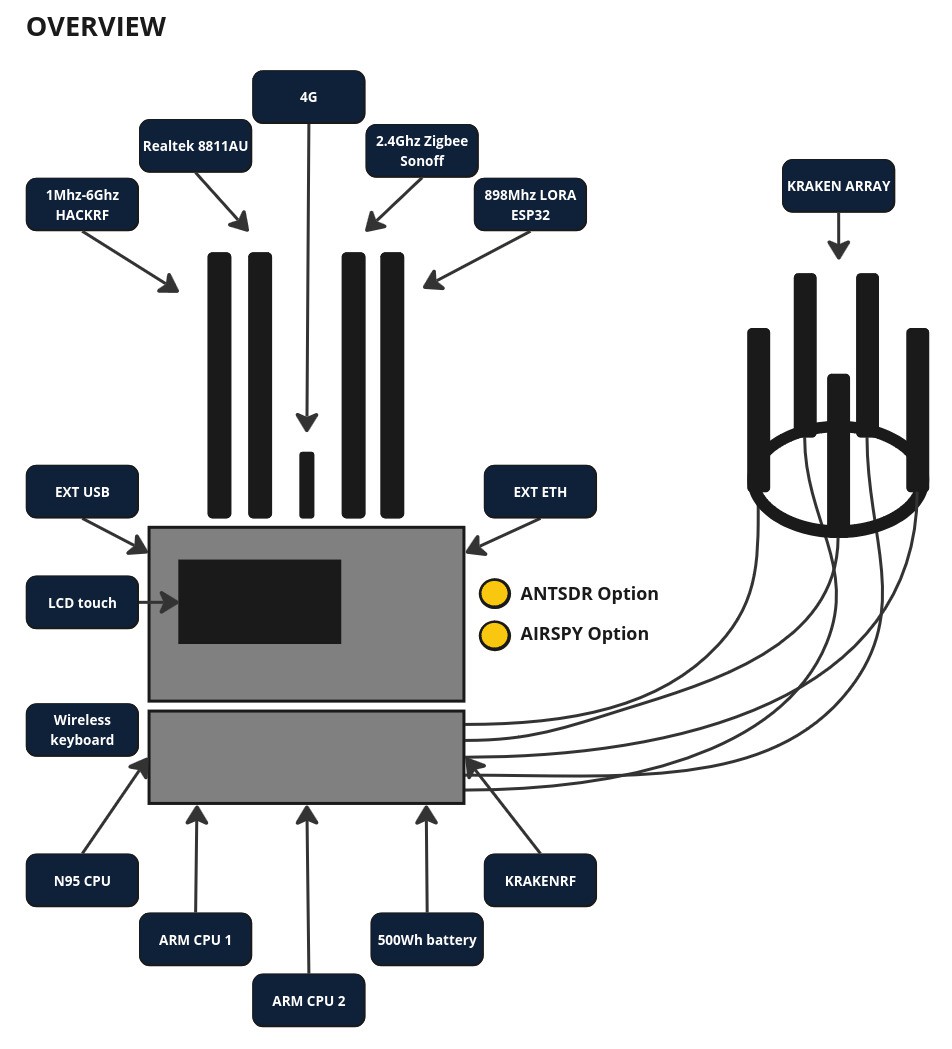
Cyberdeck Project Overview
This cyberdeck is a portable system engineered for advanced signal intelligence, cybersecurity, emergency rescue operations, resilient communications, and server functionality. It integrates multiple Software-Defined Radios (SDRs),

Technical Specifications
Core Components:
Beelink N95 (MAIN CPU):
Powered by the Intel N95 processor, offering enhanced computational power compared to single-board computers.
Equipped with 8 GB of RAM and 500 GB SSD storage, providing ample memory and fast data access for handling intensive tasks such as real-time signal processing, data analysis, and server operations.
Runs on Linux DragonOS, allowing flexibility in software deployment and integration with various SDR tools, cybersecurity applications, and server software.
Raspberry Pi 4 (SERVER 1):
Quad-core ARM Cortex-A72 processor at 1.5 GHz, 4 GB RAM.
Serves as an additional computing unit for managing less demanding tasks or as a backup system.
Raspberry Pi 3 (SERVER 2):
Quad-core ARM Cortex-A53 processor at 1.2 GHz, 1 GB RAM.
Handles auxiliary tasks, boosting overall system efficiency.
Software-Defined Radios:
HackRF: Versatile SDR platform for transmitting and receiving signals from 1 MHz to 6 GHz, used for various RF analysis tasks.
KrakenRF: Multi-channel SDR designed for precise direction finding, essential for geolocating RF signal sources.
AntSDR: High-performance SDR optimized for passive radar, capable of detecting and analyzing reflections from non-cooperative transmitters.
Power System:
Battery Pack:
42V 500Wh battery, providing long-lasting power for extended field operations.
DC-DC Converters:
Three converters from 42V to 5V for powering Raspberry Pis and other low-voltage devices.
One converter from 42V to 12V for higher power components like SDRs and the Beelink N95.
Remote Access & Connectivity:
4G Modem: Enables remote operation from any location with cellular coverage, ideal for deployments in remote areas.
ZTNA (Zero Trust Network Access):
Secured via TwinGate, offering encrypted, secure remote access to the system, ensuring data security and operational integrity.
User Interface:
Display: 10.1" LCD touchscreen for an intuitive control interface and data visualization.
Input: Bluetooth keyboard for flexible system interaction.
Resilient Communications:
LoRa Meshtastic:
Integrated LoRa (Long Range) communication module running Meshtastic firmware, enabling mesh networking over long distances with low power consumption.
Provides off-grid, peer-to-peer communication capabilities, ensuring connectivity in environments without cellular or Wi-Fi coverage.
Server Functionality:
TAK Server: The Beelink N95 can host a TAK (Tactical Assault Kit) Server, enabling real-time geospatial information sharing among team members. This provides a centralized platform for situational awareness, allowing users to share maps, sensor data, and positions, enhancing coordination during tactical operations.
ATAK Integration: Compatible with the Android Team Awareness Kit (ATAK), the cyberdeck can serve as a central hub for ATAK-enabled devices, facilitating secure communication and real-time data exchange among team members in the field. This capability is essential for military, law enforcement, and emergency response operations, ensuring that all users have up-to-date information.
Capabilities and Applications
Signal Intelligence (SIGINT):
Direction Finding: Utilizing KrakenRF, the cyberdeck can accurately pinpoint the direction of RF signal sources, essential for tracking unauthorized broadcasts or signal jammers.
Passive Radar: With AntSDR, the system can perform passive radar operations, detecting and tracking objects like aircraft, vehicles, or drones by analyzing signal reflections.
Drone Detection: Capable of identifying and monitoring drones via their RF signatures, providing valuable tools for airspace security and monitoring.
Cybersecurity Operations:
Wireless Network Penetration Testing: HackRF can test the security of wireless networks, including Wi-Fi, Bluetooth, and other RF communications, identifying vulnerabilities and bolstering defenses.
RF Jamming Detection: Configured to detect RF jamming attacks in real-time, alerting operators to potential security breaches or malicious activities.
Signal Interception and Analysis: The cyberdeck can intercept and analyze unencrypted wireless communications, offering insights into potential security threats or unauthorized transmissions within a specific area.
Surveillance and Monitoring:
Environmental Monitoring: Capable of monitoring and analyzing the RF environment, identifying suspicious activities or unauthorized transmissions in real-time.
Covert Surveillance: Its portable design and remote operation capabilities make it ideal for covert surveillance operations, allowing operators to gather intelligence discreetly.
Data Collection and Analysis: The system can continuously collect and analyze RF data, enabling long-term surveillance and monitoring of specific areas or targets.
Resilient Off-Grid Communication:
LoRa Meshtastic:
Enables long-range, low-power communication in remote areas or disaster zones without relying on traditional infrastructure.
Ideal for maintaining team communication in challenging environments, enhancing operational resilience during field missions.
Emergency Rescue Operations:
Rescue Beacon Detection: The cyberdeck can detect and locate emergency rescue beacons (e.g., Personal Locator Beacons (PLBs), Emergency Position Indicating Radio Beacons (EPIRBs), and other distress signals). This capability is essential for search and rescue teams operating in remote or disaster-stricken areas where rapid response is critical.
Signal Triangulation: Using the KrakenRF, the system can triangulate the position of a distress signal, providing precise coordinates to rescuers and significantly improving the chances of a successful rescue.
Emergency Communication Relay: The system can act as a communication relay in disaster zones, connecting rescue teams with each other and with command centers via LoRa Meshtastic and 4G networks, even when conventional communication infrastructure is down.
Tactical Operations Support:
TAK Server Hosting: The cyberdeck can function as a TAK Server, facilitating the sharing of real-time geospatial data among team members. This capability is crucial for coordinating complex tactical operations, allowing users to share maps, sensor data, and positions in a secure, centralized manner.
ATAK Device Integration: The system can serve as a communication hub for ATAK-enabled devices, ensuring seamless, secure data exchange among team members. This enhances situational awareness and operational coordination in military, law enforcement, and emergency response scenarios.
Additional Applications:
Emergency Response: Deployable in disaster zones to restore communication by analyzing available RF signals and setting up temporary networks using LoRa mesh.
Research and Development: Excellent for RF research and development, allowing experimentation with SDR applications, wireless communication technologies, and mesh networking.
Educational Tool: A practical teaching tool for students and professionals learning about SDRs, RF technologies, cybersecurity, resilient communication, and tactical operations, offering hands-on experience.
 Trond B.
Trond B.